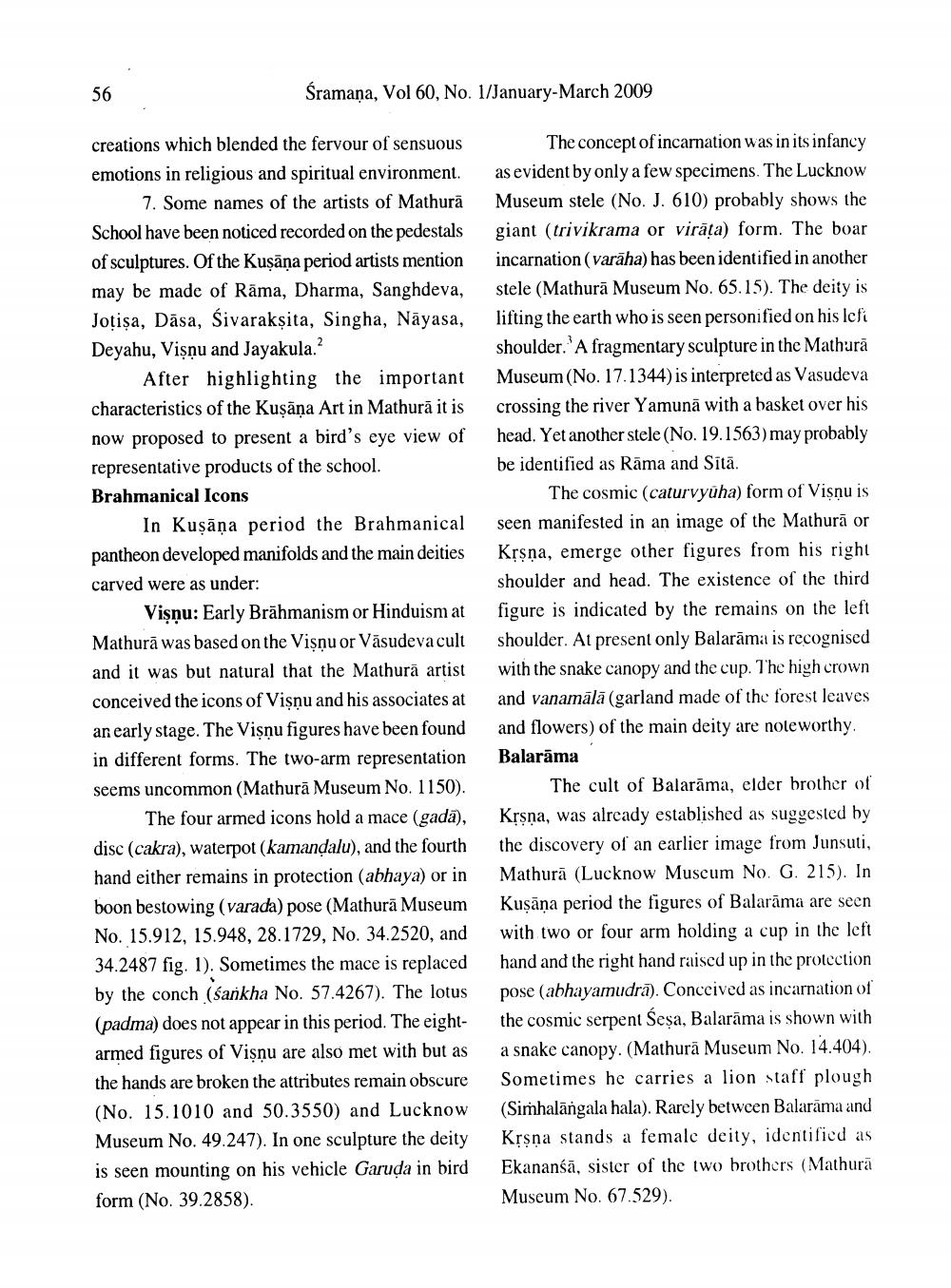________________
56
Sramaņa, Vol 60, No. 1/January March 2009
creations which blended the fervour of sensuous emotions in religious and spiritual environment.
7. Some names of the artists of Mathura School have been noticed recorded on the pedestals of sculptures. Of the Kuşāņa period artists mention may be made of Rāma, Dharma, Sanghdeva, Jotisa, Dāsa, Sivarakṣita, Singha, Nāyasa, Deyahu, Vişnu and Jayakula.?
After highlighting the important characteristics of the Kuşāņa Art in Mathurā it is now proposed to present a bird's eye view of representative products of the school. Brahmanical Icons
In Kuşāņa period the Brahmanical pantheon developed manifolds and the main deities carved were as under:
Vişnu: Early Brāhmanism or Hinduism at Mathurā was based on the Vişnu or Väsudeva cult and it was but natural that the Mathură artist conceived the icons of Visnu and his associates at an early stage. The Vişnu figures have been found in different forms. The two-arm representation seems uncommon (Mathura Museum No. 1150).
The four armed icons hold a mace (gadā), disc (cakra), waterpot (kamandalu), and the fourth hand either remains in protection (abhaya) or in boon bestowing (varada) pose (Mathura Museum No. 15.912, 15.948, 28.1729, No. 34.2520, and 34.2487 fig. 1). Sometimes the mace is replaced by the conch (sankha No. 57.4267). The lotus (padma) does not appear in this period. The eightarmed figures of Vişnu are also met with but as the hands are broken the attributes remain obscure (No. 15.1010 and 50.3550) and Lucknow Museum No. 49.247). In one sculpture the deity is seen mounting on his vehicle Garuda in bird form (No. 39.2858).
The concept of incarnation was in its infancy as evident by only a few specimens. The Lucknow Museum stele (No. J. 610) probably shows the giant (trivikrama or virāța) form. The boar incarnation (varāha) has been identified in another stele (Mathurā Museum No. 65.15). The deity is lifting the earth who is seen personified on his lefi shoulder. A fragmentary sculpture in the Mathurā Museum (No. 17.1344) is interpreted as Vasudeva crossing the river Yamunā with a basket over his head. Yet another stele (No. 19.1563) may probably be identified as Rāma and Sītā.
The cosmic (caturvyuha) form of Vişnu is seen manifested in an image of the Mathurā or Krsna, emerge other figures from his right shoulder and head. The existence of the third figure is indicated by the remains on the left shoulder. At present only Balarama is recognised with the snake canopy and the cup. The high crown and vanamālā (garland made of the forest leaves and flowers) of the main deity are noteworthy. Balarama
The cult of Balarāma, elder brother of Krsna, was already established as suggested by the discovery of an earlier image from Junsuti, Mathurā (Lucknow Museum No. G. 215). In Kuşāņa period the figures of Balarāma are seen with two or four arm holding a cup in the left hand and the right hand raised up in the protection pose (abhayamudrā). Conceived as incarnation of the cosmic serpent Sesa, Balarāma is shown with a snake canopy. (Mathura Museum No. 14.404). Sometimes he carries a lion staff plough (Simhalāngala hala). Rarely between Balarāma and Krsna stands a female deity, identified as Ekananśā, sister of the two brothers (Mathurā Museum No. 67.529).




